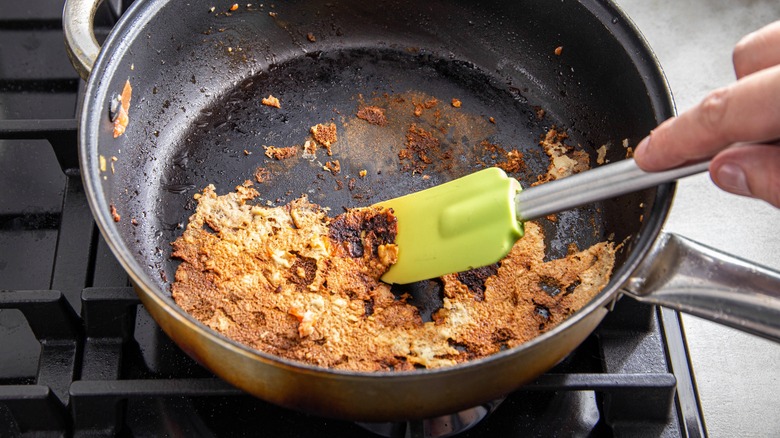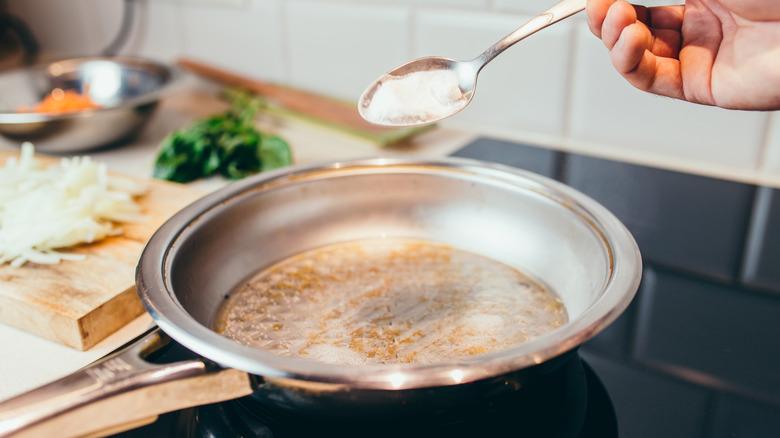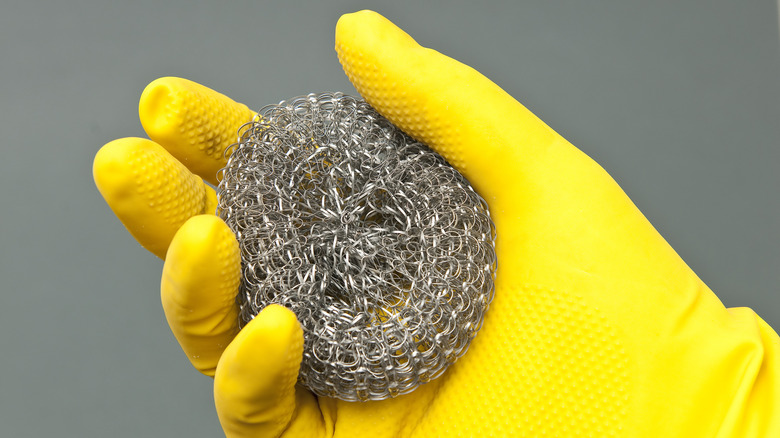The Best Way To Clean Burnt Food From Stainless Steel Pans
Doing the dishes can seem like a daunting task after enjoying a nice home-cooked meal, especially if some of that food got a little too burnt on the stovetop. Just because stainless steel pans are called "stainless" doesn't mean they shouldn't be cleaned ASAP after every use, and while it's tempting to say you'll just scrape off that burnt-on food residue tomorrow, doing it right away is easier for you and better for your pans.
When scrubbing as hard as you can just isn't cutting it, baking soda can be useful to naturally clean your kitchen. A slurry of three parts baking soda to one part water can be applied to pans to loosen burnt-on food residue and stains. Once the two are mixed together, spread the paste around the pan, making sure to thickly cover areas that have the most crust, and allow it to sit.
While a few minutes of sitting might be sufficient for smaller stains, larger amounts of char may need to rest with the pasty coating for a few hours. After the time is up, scrub the pan with a sponge or cloth. With luck, the food will be effectively loosened and will scrape right off the metal. Failing that, though, you have some other, more intense cleaning methods to try.
Boiling water can lift up stubborn food residue
You can use boiling water in two ways to "melt" food residue off of your pans. The heat of the water can loosen some of the extra-tough stuck-on bits. The first method is to submerge the entire pan inside a larger pot of boiling water. You'll want to be careful doing this and not fill up the larger pot too high, or overflow could injure you. The second method involves simply filling the burnt pan with water and allowing it to come to a boil.
After the water comes top a boil, turn the stovetop heat down to let it simmer. After a few minutes, take the pan off the heat — or out of the hot water — and let it cool down until it's safe to touch. Then, grab a sponge to scrub or a spatula to scrape up the burnt food.
If this initial clean doesn't remove all of the charred leftovers, you can repeat the process until the pan is clean. For some extra power, vinegar and baking soda can be added into the water as it boils. Additionally, white vinegar is an essential secret weapon for cleaning rainbow stains from stainless steel, if you want to get rid of that multicolored film that sometimes forms on these pans.
What to avoid when cleaning stainless steel pans
Before you clean your stainless steel pans with water, always make sure the cookware is cool to the touch. Introducing cold water to a hot pan can cause plenty of problems through the process of thermal shock, and this mistake could destroy your favorite frying pan. The temperature differences can cause the metal of the pan to grow and shrink, so the most common issue is warping, which creates an uneven cooking surface. In more extreme cases, the pan could crack or break.
While cleaning, make sure to avoid extra harsh scrubbers, like steel wool. Although these might remove burnt-on food quickly and easily, they could damage your cookware in the long run. The abrasive material can scratch the steel surface, which could later lead to rusting.
Lastly, harsh chemicals — like chlorine bleach or oven cleaner — could be detrimental to the lifespan of your pans. The intensity of these substances can wear down the coating on the pan and cause surface pitting, or small holes and dents in the metal. Any cleaners containing bleach should probably be avoided, and your pan's specific cleaning instructions should always be followed.



